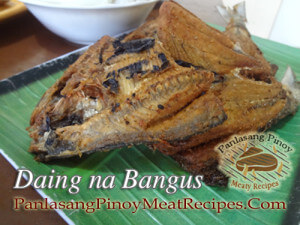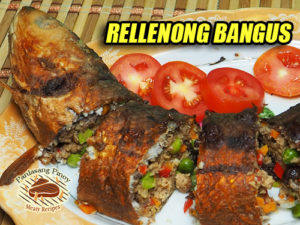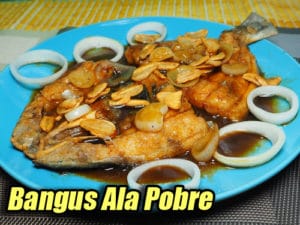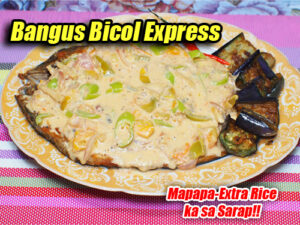Are you running out of ideas on how to cook your favorite bangus or milkfish? If this fish is one of your favorite food then I think this bangus curry will be a great addition to your menu. Provided that you also love to eat dish with curry in it. If you like chicken curry, then I think you will love this dish also. Not only this is a delicious dish, it is also easy to cook and to prepare.
All you have to do is buy a boneless bangus and all the rest of the ingredients listed in the recipe below. Then you are ready to cook! The only tedious task is deboning the bangus but now a days you can easily buy it in wet markets which the fish vendor will gladly do the deboning for you or you can also purchase it in the supermarket already repacked and frozen in the fish section.
Bangus Curry: A Family Favorite Turned New Twist
Growing up in Nueva Ecija, bangus was always a staple on our dining table. My father, Mang Tonyo, swore by the freshness of the milkfish from the local palengke, and my mother had at least ten different ways to cook it — from sizzling sisig-style to the classic paksiw. But one rainy afternoon, my Tita Lorna came over with a curious idea she picked up from a neighbor in Pampanga: “Why not make bangus curry?” she said with a mischievous grin, as if she was about to start a kitchen revolution.
It sounded strange at first. Curry was for chicken or beef, right? But we decided to give it a try, and that first spoonful changed the way we looked at our humble milkfish forever. The rich coconut cream, the earthy warmth of curry powder, and the familiar soft yet meaty bangus came together in a dish that felt both exotic and comfortingly Filipino.
Choosing the Best Bangus for Bangus Curry
For this recipe, freshness is everything. My Kuya Jun always says, “If the eyes are clear and the gills are bright red, you’re halfway to a delicious meal.” Of course, you can save yourself some work by buying pre-deboned bangus from the supermarket. Gone are the days when you had to spend an hour fishing out those tiny bones while your stomach growled in protest.
The technique of seasoning the bangus with calamansi juice before dredging it in cornstarch and flour isn’t just for flavor — it helps cut through the natural fishiness and creates a tangy base that complements the curry sauce later. Frying the fish until golden brown ensures it stays crispy even when you ladle that luscious curry sauce on top.
Why Fry First Before Adding the Curry Sauce
Some beginners ask, “Can I just simmer the raw fish in the sauce?” Technically, yes, but you’d miss out on that wonderful crisp skin and the richer flavor from frying. My Ate Maribel taught me that frying seals in the juices, giving you a bangus that stays tender inside while holding up against the sauce outside. Plus, the browned bits left in the pan after frying are perfect for adding depth to your curry base when you sauté the aromatics.
Cooking the Curry Sauce the Filipino Way
Start by sautéing onion and garlic until they’re fragrant — the kind of smell that makes neighbors suddenly remember they need to “drop by” your house. Add tomatoes and cook until they’ve melted into a sweet, tangy paste. Carrots and potatoes follow, simmered just until they’re fork-tender.
Here’s where the magic happens: curry powder, coconut cream, and a bit of water come together into a golden, velvety sauce. The curry powder brings warmth and spice, while the coconut cream gives it that distinct tropical richness we Filipinos love. Patis and a pinch of sugar balance the flavors — salty, savory, slightly sweet. If you like a kick, toss in a siling labuyo or two.
The science here is simple. Coconut cream coats your taste buds, letting the spices linger longer, while the patis adds that unmistakable umami depth. The short simmer allows all the flavors to marry without overcooking the vegetables.
A Bit of Curry History in the Philippines
Curry isn’t originally Filipino, but our kitchens have a way of making any dish feel like home. Indian traders introduced the concept centuries ago, and over time, we swapped their spices for what was available locally. That’s why Filipino curries often have coconut cream, patis, and a gentler spice profile. This bangus version is proof that our cuisine thrives on adaptation — taking an idea from afar and making it unmistakably ours.
Serving Suggestions and Family Traditions
In our house, bangus curry is always served with steaming white rice. My Lola Pilar insists it should be sinandomeng, slightly sticky so it soaks up the sauce perfectly. On special occasions, we serve it with a side of atchara, the pickled papaya adding a refreshing contrast to the rich curry.
One summer, during a family reunion in Pangasinan, my cousin Boyet made this dish using freshly caught bangus from the fishpond. We set up a long table under the mango trees, everyone passing around plates while kids ran barefoot in the yard. The curry was gone in minutes, and Boyet barely had time to sit down before his Tita Lina asked him to fry another batch.
Final Thoughts on Bangus Curry
Bangus curry is proof that our beloved milkfish can shine in unexpected ways. It’s easy enough for beginners, forgiving of small mistakes, and endlessly customizable depending on what vegetables or spices you have on hand. More than just a recipe, it’s a reminder that food is about sharing — not just flavors, but stories, laughter, and little moments that make each meal memorable.
So the next time you’re staring at a fresh bangus, wondering what to do with it, remember my Tita Lorna’s kitchen gamble. Fry it golden, bathe it in coconut curry sauce, and watch as your family falls in love with bangus all over again.
How to Cook Bangus Curry
Ingredients
- 2 pcs boneless bangus (medium size)
- 1/4 cup all-purpose flour
- 1/4 cup cornstarch
- black pepper to taste
- Salt to taste
- 3 cloves minced garlic
- 1 pc small onion
- 1 pc thumb-sized minced ginger
- 1 pc tomato
- 1/2 cup water
- 1 1/2 cup coconut milk
- 1 pc red bell pepper diced
- 1 pc carrot peeled and diced
- 1 pc potato peeled and diced
- 2 Tbsp curry powder
- 1 Tbsp sugar
- 2 Tbsp fish sauce
- 2 pieces finger chili
- cooking oil for frying
- 4 pcs calamansi (extract the juice)
Instructions
How to Cook Bangus Curry
- Season bangus with salt and pepper. Sprinkle calamansi juice all over the fish.
- In a deep plate, combine cornstarch, flour, salt and pepper. Mix until well combined. Dredge the bangus until well coated.
- Heat cooking in a pan and fry the bangus until golden brown. When done, transfer to a wire rack and let it cool. This way the skin will be crunchy and not soggy.
- Heat about 2 Tbsp of oil or butter in a pan and sauté onion and garlic until fragrant. Add the tomatoes and stir. Simmer until the tomatoes are soft.
- Add carrots and potatoes and a little bit of water about 1/2 cup. Let it simmer for 2 to 3 minutes until the carrots and potatoes are fork tender.
- Add curry powder, coconut cream and 1/2 cup water. Simmer for a few minutes while stirring.
- Season the sauce with patis and sugar while stirring. Add siling labuyo to make it slightly spicy.
- To assemble the bangus curry, put the fried bangus in a serving plate and pour the curry sauce over the bangus when ready to serve.
Video
Notes
Cooking Tips:
Choose Fresh and Pre-Deboned Bangus
Fresh milkfish makes all the difference in flavor and texture. Look for clear eyes, bright red gills, and firm flesh to ensure quality. If you want to save time, buy pre-deboned bangus from the market or supermarket so you can focus on cooking instead of picking out bones.Fry to Lock in Flavor and Texture
Coating the bangus in flour and cornstarch before frying creates a crisp outer layer that holds up well against the curry sauce. Frying first also locks in the fish’s natural juices, keeping it tender inside. Letting the fish rest on a wire rack after frying prevents the skin from turning soggy.Balance the Curry Sauce Flavors
Use coconut cream for a rich, velvety base that complements the mild taste of milkfish. Adjust the curry powder, patis, and sugar slowly, tasting as you go to find the right balance of savory, spicy, and sweet. Adding siling labuyo gives a pleasant heat without overpowering the delicate fish.





